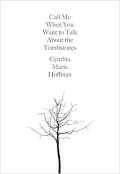This Is Your Family Tree (excerpt)
My mother and I walk at Rose Hill. We photograph each otherbending toward the names that belong to us: our Kittie, our MostExcellent Samuel Shannon. It is raining.Though we expected the dead, there is nothing but grass, trees.Only the stones in their various shades of gray to disrupt thegentle arch of the hill as it dips into the valley.The rain touches everything, indiscriminate, creeps into theruffled folds even before the carnation touches the stone.This is a map of the graveyard. I stand above the grave of KittieShannon. The tree is a mathematical structure. Some say the rootsare a mirror image of the tree itself.One requires an imagination to visit with the dead in such a place.Have you ever stopped to think how many drops of blood are inyour body that are actually related to these people? Maybe halfa drop.A carnation is nothing. How much does it weigh?Both graves, in the photographs, the days of their funerals, youcan’t tell one from the other. Our Kittie our Samuel, buried inpounds and pounds of flowers.What happens to the coffin when it rains? No one tells you thesethings.A raindrop falls. Our image slips along its glassy surface , theliving and the dead all of us. Look quick, your stone face, your coldbody beneath the umbrella plummeting to the earth.What do you think they’re thinking down there for nearly twohundred years? Are they sick of what they’re wearing? And whathas become of his cufflinks?My mother’s body in a raindrop, a flash in a crystal ball no biggerthan a fingernail, smaller than a fingernail.Are they not like sunken ships? Can we not think that of them,lying in the dark, blind? But don’t tell me. I don’t want to know.I don’t want to think about that. I want to be more related thanthat.If we have seen the photographs, read the letters in their ownhandwriting, the ink from their pens. The pen in the hand. If weentered their house.The graveyard was quite lovely. Don’t you think it was lovely, howquiet it was?
Feature Date
- December 5, 2018
Series
Selected By
Share This Poem
Print This Poem
Copyright © 2018 by Cynthia Marie Hoffman.
All rights reserved.
Reproduced by Poetry Daily with permission

New York, New York
In this book-length poetry sequence, a mother inherits a leather box that was her grandmother’s. Her daughter joins her on a reconstruction of family history. Together they traipse through graveyards and sift through endless photos and clippings, piecing together what used to be in order to understand who they are.
“Hoffman builds a fascinating collage of family stories, photographs, letters, and poetry. . . . Intricate and intelligent, these poems reveal the heart of the genealogical craze—to face mortality, and find a way to remember and be remembered.”
— Camille-Yvette Welsch, Foreword Reviews
“Cynthia Marie Hoffman obsessively and nimbly combs, witnessing histories both harrowing and common, and it is her practice of hand and mind that moves us, as readers, to view each living dace before us as subject to the one last face: death—and us, in turn, as future mourners. This virtuosic, lyrical meditation can therefore orient us ethically, deeply, and beautifully to each other and to our mortal selves.”
— Katie Ford
“Call Me When You Want To Talk About the Tombstones is a haunting, thrilling experience. Each line of Hoffman’s tactile, incandescent poetry recovers, for a moment, the irrecoverable past with stunning”
— Nick Lantz
Poetry Daily Depends on You
With your support, we make reading the best contemporary poetry a treasured daily experience. Consider a contribution today.




